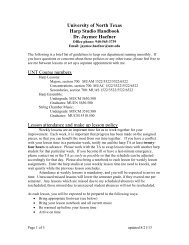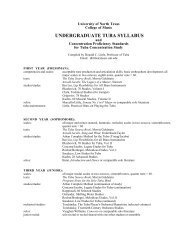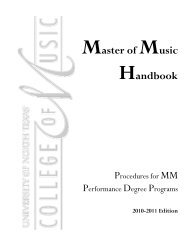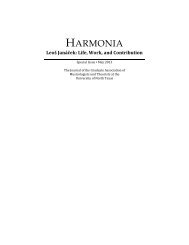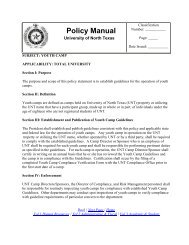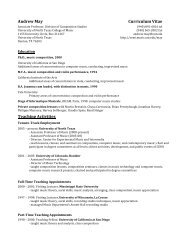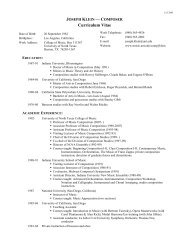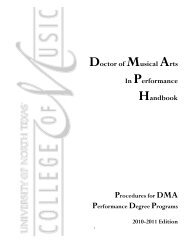“Reed Information” by Tom Ridenour - UNT College of Music
“Reed Information” by Tom Ridenour - UNT College of Music
“Reed Information” by Tom Ridenour - UNT College of Music
Create successful ePaper yourself
Turn your PDF publications into a flip-book with our unique Google optimized e-Paper software.
Reed Information<br />
<strong>by</strong> <strong>Tom</strong> <strong>Ridenour</strong><br />
The reed is not a mystery and reed-making and adjustment are not voodoo! The reed obeys the<br />
laws <strong>of</strong> physics. A clear understanding <strong>of</strong> these laws will enable the player to adjust reeds and make<br />
reeds through logic.<br />
--<strong>Tom</strong> <strong>Ridenour</strong><br />
I. Good cane has:<br />
A. Golden color<br />
B. Smooth, shiny bark<br />
C. Straight, evenly spaced fibers<br />
II. Reed and Mouthpiece<br />
A. The reed’s vamp proportions must conform to the mouthpiece facing<br />
B. No reed-fixing methods can be blindly implemented without considering the<br />
mouthpiece facing’s characteristics.<br />
III. Quality and Cut<br />
A. Fallacy: Bad reeds are due to bad cane.<br />
Truth: Bad reeds are mostly due to bad shape.<br />
B. Good cane makes the difference once the proper shape and proportions have<br />
been attained<br />
IV. Reed vibration<br />
A. The center <strong>of</strong> the reed vibrates at the speed <strong>of</strong> the fundamental<br />
B. The edges <strong>of</strong> the tip vibrate at the speed <strong>of</strong> the overtones<br />
C. A reed has to seal air-tight to start the vibration cycle<br />
V. Air and Embouchure<br />
A. Ears and tip areas control sensitive air pressure<br />
B. Lip contact area in heart controls sensitive lip pressure<br />
VI. Flex must be Perfectly Smooth Without Stiff Areas or Gaps<br />
VII. Reed Tip is critical for upper register response. In a properly made mouthpiece<br />
the reed tip should be <strong>of</strong> an even thickness all the made way across.<br />
VIII. Reed Proportions<br />
A. Side to side should be even to conform to evenly made mouthpiece rails<br />
B. Tip to back<br />
1. If the reed feels heavy for the air and light for the lip, the tip is too heavy<br />
2. If the reed feels heavy for the lip and light for the air, the back is too heavy<br />
3. If the tone is hard, the tip is too thick<br />
62
4. If the tone is pure, but unresponsive in staccato, the tip is too thin<br />
5. If the tone is “breathy,” the reed is poorly balanced<br />
6. If the reed plays well forte, but collapses at piano, the tip is too thin<br />
IX. Reed Balancing Procedure<br />
A. Place the reed straight on the facing for the playing test.Play the reed at all<br />
dynamics. Is the tone clear in all dynamics? Do you have to change embouchure pressure<br />
excessively to slur easily in the high register? Can you play s<strong>of</strong>tly in all registers? Is the<br />
staccato responsive?<br />
B. After playing the reed a few minutes, check the balance <strong>of</strong> the ears or sides <strong>of</strong><br />
the reed. Deaden the right side <strong>of</strong> the reed and listen to the left side. Reverse the process. Test<br />
using sfz>p. Do the ears sound the same? Do they have the same decay resonance in sfz>p?<br />
B. Remove the reed from the mouthpiece and flex the tip <strong>of</strong> the reed to Does the flex<br />
from side to side confirm your playing test? Circle the stiff areas, or “hard spots,” with a<br />
pencil while you are looking at them. Is the tip <strong>of</strong> the reed the same thickness all the way<br />
across?<br />
D. Thin the hard area and repeat steps 1, 2, 3 & 4 until the ears are balanced. If<br />
the reed is then s<strong>of</strong>t, clip a small amount and re-test<br />
E. Testing for side-to-side reed balance<br />
1. Alternately deaden the left and right sides <strong>of</strong> the reed and play<br />
2. A properly balanced reed will have the same tone, response and decay on<br />
both sides <strong>of</strong> the reed<br />
X. Fine Placement <strong>of</strong> the Reed On the Mouthpiece<br />
A. If the reed is s<strong>of</strong>t, move it up<br />
B. If the reed is hard, move it lower<br />
C. If the reed plays slightly harder on one side than the other, tilt the reed away<br />
from the harder side; this has the effect <strong>of</strong> thinning the mouthpiece rail on the<br />
harder side and widening the s<strong>of</strong>ter side; correct placement is arrived when<br />
the sides play and decay with the same response and resonance, and the<br />
altissimo is instantly responsive at s<strong>of</strong>t dynamics<br />
XI. Test for High Register Reed Balance<br />
A. Play high tones with breath attacks; notice the amount <strong>of</strong> air embouchure<br />
pressure necessary to begin the tone; determine if the reed sluggish to speak<br />
unless inordinate embouchure pressure is added<br />
B. Play E3 and slur to A3<br />
1. If A3 speaks freely with a full tone, the reed has good tip balance and will<br />
play the upper altissimo register securely<br />
2. If A3 fails to speak, requires added embouchure pressure in speaking, or<br />
has a narrow or confined tone color, there is imbalance in the final few<br />
millimeters <strong>of</strong> the reed tip<br />
XII. Miscellaneous<br />
A. Fallacy: a hard reed is necessary to play the highest tones<br />
Truth: while certain minimal strength in the heart <strong>of</strong> the reed is necessary to<br />
play the high tones, good high register response is mostly due to the<br />
fine balance <strong>of</strong> the last 3 mm <strong>of</strong> the reed and the left and right ears<br />
B. Fallacy: a s<strong>of</strong>t reed has a clear sound and quick response, while a hard reed is<br />
<strong>of</strong>ten fuzzy and slow in response<br />
Truth: Clarity and response are due to proper balance in the reed; properly<br />
balance, a hard reed may have excellent response and fine clarity while<br />
requiring very little embouchure pressure to center the sound<br />
63




